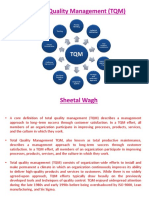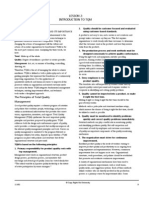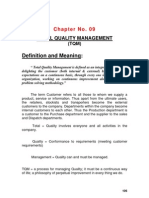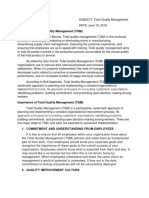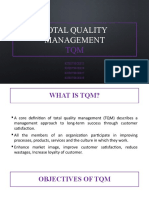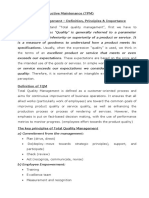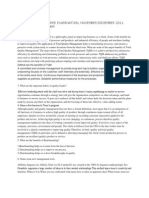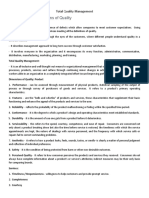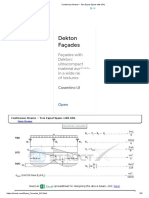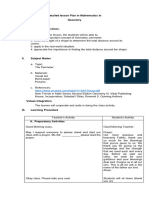Unit 10 Quality Management
Unit 10 Quality Management
Uploaded by
huyennb415Copyright:
Available Formats
Unit 10 Quality Management
Unit 10 Quality Management
Uploaded by
huyennb415Copyright
Available Formats
Share this document
Did you find this document useful?
Is this content inappropriate?
Copyright:
Available Formats
Unit 10 Quality Management
Unit 10 Quality Management
Uploaded by
huyennb415Copyright:
Available Formats
Unit 10 Quality Management
1. Quality Management
Quality management is the act of overseeing different activities and tasks within an organization to
ensure that products and services offered, as well as the means used to provide them, are
consistent. It helps to achieve and maintain a desired level of quality within the organization.
1.1 Components of Quality management
Quality Planning – The process of identifying the quality standards relevant to the project and
deciding how to meet them.
Quality Improvement – The purposeful change of a process to improve the confidence or
reliability of the outcome.
Quality Control – The continuing effort to uphold a process’s integrity and reliability in achieving
an outcome.
Quality Assurance – The systematic or planned actions necessary to offer sufficient reliability so
that a particular service or product will meet the specified requirements.
1.2 The aim of quality management
It is to ensure that all the organization’s stakeholders work together to improve the company’s
processes, products, services, and culture to achieve the long-term success that stems from
customer satisfaction.
2. Just-in-time inventory system (JIT)
2.1 What is JIT?
- The management principle: Right product- Right quantity- Right place- Right time
- JIT is a management strategy that aligns raw-material orders from suppliers directly with
production schedules.
- The purpose is to increase efficiency and decrease waste by receiving goods only as they need
them for the production process, which reduces inventory costs. This method requires producers to
forecast demand accurately.
- JIT is a management strategy that minimizes inventory and increases efficiency.
- JIT manufacturing came into existence in 1930 in USA by Ford Automobils but it is well-known
as the Toyota Production System (TPS) because the car manufacturer Toyota adopted the system in
the 1970s.
- The success of the JIT production process relies on steady production, high-quality workmanship,
no machine breakdowns, and reliable suppliers.
Application:
- For manufacturing companies whose production procedures are repeated
- It is more suitable for small companies where the management of production and administration
is more flexible.
2.2 Advantages and Disadvantages of JIT
Advantages:
More cost-efficient production.
Continuous quality improvement.
Waste Elimination.
Improve productivity.
Improve supplier relationships.
Improve storage space used.
Reduce costs associated with storage.
Reduce manufacturing time.
Disadvantages:
Complexity in planning.
Lack of working capital.
Supply chain failures.
No opportunity costs.
Compromise on quality.
Industry specific.
3. Total quality management (TQM)
https://www.techtarget.com/searchcio/definition/Total-Quality-Management
3.1 What is TQM?
- Total quality management (TQM) is an ongoing process of detecting and reducing or eliminating
errors.
- It is used to streamline supply chain management, improve customer service, and ensure that
employees are properly trained.
- The focus is to improve the quality of an organization's outputs, including goods and services,
through the continual improvement of internal practices.
- It aims to hold all parties involved in the production process accountable for the overall quality of
the final product or service.
3.2 Principles of TQM
The eight guiding principles that TQM uses to improve quality include the following:
Customer focus. The customer determines the quality level of the products and services.
Customer input is valued, as it provides a better understanding of what the customer needs.
Employee involvement. All employees must participate in the processes and system. They
must be properly trained and given the needed resources to complete their tasks on time.
Focus on process. Processes must be continually analyzed to identify weaknesses. Every
employee who takes part in the process should be properly educated in their contributions,
ensuring the right steps are taken at the right time.
Integrated business systems. All TQM processes should be integrated into a business process.
Integrated systems convey potentially useful data across departments, enabling everyone to be
on the same page.
Strategic and systematic approach. Planning and management are required using a strategic
plan with quality as a base component.
Continual improvement. A focus on continually improving quality helps an organization
adapt to changing markets and achieve competitive advantages.
Focus on data. Data should be collected, documented and analyzed to improve decision-
making accuracy and to predict trends based on previous history.
Communication. Communication between teams with information such as strategies,
methodologies or timeliness is essential to improving operations. Good communication can also
motivate employees and improve morale.
3.3 The advantages and disadvantages of TQM
(1) Advantages of TQM
Less product defects. An objective of TQM is to create products and services correctly the first
time. This means that products ship with fewer defects, reducing product recalls, future
customer support overhead and product fixes.
Satisfied customers. High-quality products that meet customers' needs result in higher
customer satisfaction. High customer satisfaction, in turn, can lead to increased market share,
revenue growth via upselling and word-of-mouth marketing initiated by customers.
Lower costs. As a result of less product defects, companies save money on customer support,
product replacements, field service and creating product fixes. The cost savings flow to the
bottom line, creating higher profit margins.
Well-defined cultural values. Organizations that practice TQM develop and nurture core
values around quality management and continuous improvement. The TQM mindset pervades
across all aspects of an organization, from hiring to internal processes to product development.
(2) Disadvantages of TQM
Planning and resources. TQM needs a significant amount of planning and resources over time
to be properly allocated to the change.
Companywide commitment. Continuous improvement in TQM means the organizational
culture must focus on improving processes. All management levels must be supportive.
Added costs. TQM might add training, infrastructure and team development costs.
Time. It might take years for an organization to fully show intended results.
Partial efforts. Because of the effort involved in implementing TQM, a partial move toward it
can result in failure.
You might also like
- En 1337-4Document31 pagesEn 1337-4Rahul100% (3)
- Histología Veterinaria DellmanDocument204 pagesHistología Veterinaria DellmanPABLO CESAR BRUNO CAMPOSNo ratings yet
- Materials ManagementDocument41 pagesMaterials ManagementManohar Gupta100% (1)
- House Rent Prediction EDADocument35 pagesHouse Rent Prediction EDAMr. MysteryNo ratings yet
- Total Quality ManagementDocument14 pagesTotal Quality ManagementNishant Jain60% (10)
- Total Quality ManagementDocument23 pagesTotal Quality ManagementXhunterXNo ratings yet
- Total Quality Management (TQM)Document31 pagesTotal Quality Management (TQM)malathi100% (1)
- Assignment SEQDocument13 pagesAssignment SEQVicky KdNo ratings yet
- TQM1.1Document8 pagesTQM1.1greedharry TNo ratings yet
- Total Quality Management (TQM)Document35 pagesTotal Quality Management (TQM)cyndrellaNo ratings yet
- Total Quality Management?: Approach That Focuses On Continuous Quality Improvement of Products and Services byDocument7 pagesTotal Quality Management?: Approach That Focuses On Continuous Quality Improvement of Products and Services bytushar umraoNo ratings yet
- Strategic Cost Management Parts V-VII Part V: Total Quality Management and Just-in-Time ApproachDocument11 pagesStrategic Cost Management Parts V-VII Part V: Total Quality Management and Just-in-Time ApproachChin FiguraNo ratings yet
- Module 1 Notes - 18ME734.Document17 pagesModule 1 Notes - 18ME734.SANTOSH0% (1)
- Definition of Total Quality Management (TQM)Document6 pagesDefinition of Total Quality Management (TQM)Tamizha Tamizha100% (1)
- IQC CH 6Document16 pagesIQC CH 6AKSHIT 12No ratings yet
- Why Is Online Shopping A Better Experience On Some Sites and Not On OtherDocument4 pagesWhy Is Online Shopping A Better Experience On Some Sites and Not On OtherJulienne LobchoyNo ratings yet
- Quality Control Lecture 3 & 4Document45 pagesQuality Control Lecture 3 & 4Turyamusiima CleverNo ratings yet
- Notes 6. Total Quality ManagementDocument7 pagesNotes 6. Total Quality ManagementGastor Hilary MtweveNo ratings yet
- Concepts of Total Quality ManagementDocument4 pagesConcepts of Total Quality ManagementJethrine Ann Tomas PasianNo ratings yet
- Total Quality ManagementDocument18 pagesTotal Quality ManagementTrilok GoolabNo ratings yet
- Total Quality ManagementDocument9 pagesTotal Quality ManagementEvanjo NuquiNo ratings yet
- 2 TQM 1Document3 pages2 TQM 1Kristel Anne RunasNo ratings yet
- Lesson 2: Introduction To TQM: The Principles of Total Quality ManagementDocument6 pagesLesson 2: Introduction To TQM: The Principles of Total Quality Managementmvilla2488No ratings yet
- Total Quality Management: Assignment 01Document9 pagesTotal Quality Management: Assignment 01Lasitha NawarathnaNo ratings yet
- What Is Total Quality ManagementDocument7 pagesWhat Is Total Quality ManagementhajymNo ratings yet
- DCM 222/quality Management Introduction and Implementation of Total Quality Management (TQM)Document6 pagesDCM 222/quality Management Introduction and Implementation of Total Quality Management (TQM)johnNo ratings yet
- What Is Quality?Document4 pagesWhat Is Quality?Ali ZeeshanNo ratings yet
- TQM & GITDocument18 pagesTQM & GITforeverhituNo ratings yet
- Nature of Operations ManagementDocument2 pagesNature of Operations Management727822TPMB121 PRIYADHARSHINI.MNo ratings yet
- Company Wide Quality ManagementDocument46 pagesCompany Wide Quality ManagementYogita Ghag Gaikwad100% (1)
- TQMDocument13 pagesTQMParamesh PalanichamyNo ratings yet
- Updated OMTQM ReportingDocument28 pagesUpdated OMTQM Reportingmahisam293No ratings yet
- QualityDocument113 pagesQualityleesadzebondeNo ratings yet
- TQM (Total Quality Management) : 1. Customer FocusDocument5 pagesTQM (Total Quality Management) : 1. Customer FocusmpatroNo ratings yet
- ASSIGNMENT ON TQM - 3924804 - Himasha Samaranayaka.Document10 pagesASSIGNMENT ON TQM - 3924804 - Himasha Samaranayaka.himashasamaranayakaNo ratings yet
- Total Quality ManagementDocument2 pagesTotal Quality Managementkaushikbose81No ratings yet
- THOUGHT CHPTER SEVEN ThoughtDocument24 pagesTHOUGHT CHPTER SEVEN ThoughtJulianNo ratings yet
- Tvet Programme Title Autonotive Servicing Opration Management Level 4Document61 pagesTvet Programme Title Autonotive Servicing Opration Management Level 4enale endrisNo ratings yet
- Kmbn205 Unit 5Document26 pagesKmbn205 Unit 5akshitbhardwaj790No ratings yet
- Total Quality Management: By: Zaipul Anwar Manager, R & D Dept. Business & Advanced Technology Centre UTMDocument14 pagesTotal Quality Management: By: Zaipul Anwar Manager, R & D Dept. Business & Advanced Technology Centre UTMविशाल छुगानीNo ratings yet
- Quality Management MINI Project OnDocument11 pagesQuality Management MINI Project OnGok L Tuna100% (1)
- Quality Management Practices by TVS Group IndiaDocument19 pagesQuality Management Practices by TVS Group Indiasnata92No ratings yet
- TQMDocument3 pagesTQMArlyn Ramirez IINo ratings yet
- Cost Reduction and Increased Profitability: What Are The Benefits of Total Quality Management?Document5 pagesCost Reduction and Increased Profitability: What Are The Benefits of Total Quality Management?Joshua AureliaNo ratings yet
- Total Quality ManagementDocument20 pagesTotal Quality ManagementBinod ShresthaNo ratings yet
- Assignment 6Document10 pagesAssignment 6api-723710078No ratings yet
- Kmbn205 Unit 5Document27 pagesKmbn205 Unit 5akshitbhardwaj790No ratings yet
- UNIT-3: Total Productive Maintenance (TPM) Total Quality Management - Definition, Principles & ImportanceDocument21 pagesUNIT-3: Total Productive Maintenance (TPM) Total Quality Management - Definition, Principles & ImportanceLavanya C.KNo ratings yet
- Lesson One Introduction To TQMDocument21 pagesLesson One Introduction To TQMNelly MuseiNo ratings yet
- Module 6Document22 pagesModule 6itsdaloveshot naNANAnanaNo ratings yet
- Managing For Quality and ProductivityDocument12 pagesManaging For Quality and ProductivityJamil Kamara100% (1)
- Total Quality Management By: Mohamed Ayman Abdallah Student in The Faculty of Nursing, Beni Suef National University 2023Document18 pagesTotal Quality Management By: Mohamed Ayman Abdallah Student in The Faculty of Nursing, Beni Suef National University 2023Mohamed AymanNo ratings yet
- Lecture 1 - Introduction To TQMDocument7 pagesLecture 1 - Introduction To TQMmercy.meau2006No ratings yet
- Basic Concept of TQMDocument2 pagesBasic Concept of TQMChristian lugtuNo ratings yet
- TQM QP PDFDocument13 pagesTQM QP PDFAnjana AnupNo ratings yet
- Total Quality 621Document9 pagesTotal Quality 621Keith KagandeNo ratings yet
- Module 6Document21 pagesModule 621-36142No ratings yet
- Quality Management Tools: Cause-And-Effect DiagramDocument4 pagesQuality Management Tools: Cause-And-Effect DiagramDevi PriyaNo ratings yet
- Novemberdecember 2011Document14 pagesNovemberdecember 2011Priyadharshni SelvarajNo ratings yet
- Total Quality ManagementDocument4 pagesTotal Quality ManagementKrisha Pioco TabanaoNo ratings yet
- TQM Unit-IDocument19 pagesTQM Unit-IKalyan NaniNo ratings yet
- PQMDocument5 pagesPQMRahul SoniNo ratings yet
- Unit 9 LogisticsDocument4 pagesUnit 9 Logisticshuyennb415No ratings yet
- Chapter 4Document48 pagesChapter 4huyennb415No ratings yet
- Chapter 5Document46 pagesChapter 5huyennb415No ratings yet
- Chapter 2Document37 pagesChapter 2huyennb415No ratings yet
- Odi2-065r17m18jj02-Gq V1 DS 2-0-1Document4 pagesOdi2-065r17m18jj02-Gq V1 DS 2-0-1morten.eriksenNo ratings yet
- Physics ProblemsDocument2 pagesPhysics ProblemsDiana StavaracheNo ratings yet
- Deflection Continuous Beams - Two Equal Spans With UDLDocument2 pagesDeflection Continuous Beams - Two Equal Spans With UDLAnamaria SuzanaNo ratings yet
- Musicplayer - Docx Usining PythonDocument45 pagesMusicplayer - Docx Usining PythonTony beraNo ratings yet
- 3.4 Make UpDocument10 pages3.4 Make UpDiego Nicholls FrancoNo ratings yet
- Pure Culture Preparation and Plating Technique PDFDocument17 pagesPure Culture Preparation and Plating Technique PDFAman NasirNo ratings yet
- Resort Literature Study 1 PDFDocument1 pageResort Literature Study 1 PDFMADHU MNo ratings yet
- Laboratory Report 7Document5 pagesLaboratory Report 7Azizul Ridhuan Wahid17% (6)
- Psychology Thesis Defense by SlidesgoDocument45 pagesPsychology Thesis Defense by SlidesgoWidya HastutiNo ratings yet
- Development of The Placenta and Its FunctionDocument27 pagesDevelopment of The Placenta and Its FunctionColince johnsonNo ratings yet
- Your English Pal ESL Lesson Plan Fear v1Document4 pagesYour English Pal ESL Lesson Plan Fear v1Adrianna SzczepanekNo ratings yet
- LESSON PLAN PerimeterDocument6 pagesLESSON PLAN Perimeterannarose bongcayaoNo ratings yet
- Guide For Safehull Condition Assessment-TankersDocument8 pagesGuide For Safehull Condition Assessment-TankersThe MatrixNo ratings yet
- Sinumerik Sinumerik 840D SL ISO Turning: 1 2 3 4 5 A B C D EDocument200 pagesSinumerik Sinumerik 840D SL ISO Turning: 1 2 3 4 5 A B C D EPhilippe jean-louisNo ratings yet
- Research Glenn 2Document43 pagesResearch Glenn 2Cheru BibzNo ratings yet
- Descriptive ResearchDocument9 pagesDescriptive ResearchIrish MiguelNo ratings yet
- InterstellarWORKSHEET 2Document3 pagesInterstellarWORKSHEET 2harryssi2208No ratings yet
- The Solution of Nonlinear Equations Iteration For Nonlinear SystemsDocument9 pagesThe Solution of Nonlinear Equations Iteration For Nonlinear SystemsMg ChanNo ratings yet
- Chapter 3 DoneDocument5 pagesChapter 3 DoneJERRICO TENEBRO100% (1)
- Experiment No.6Document4 pagesExperiment No.6Cabacungan, Michael RayNo ratings yet
- Reading 6-Unit 8Document24 pagesReading 6-Unit 8limenunu100% (1)
- Culture of MeralcoDocument2 pagesCulture of Meralcoolaliajohnpaolo2324No ratings yet
- ORX Exploring Risk Exposure Methodologies 2020 Summary ReportDocument21 pagesORX Exploring Risk Exposure Methodologies 2020 Summary ReportRhamu Oliveira100% (1)
- Madeleine LeiningerDocument4 pagesMadeleine LeiningersusulanjrNo ratings yet
- Current DPPDocument14 pagesCurrent DPPwattariq47No ratings yet
- StandardReport - 3 2 2021 - 23 27 58Document1 pageStandardReport - 3 2 2021 - 23 27 58mont krstoNo ratings yet
- Nursing Theory: Roy Adaptation ModelDocument11 pagesNursing Theory: Roy Adaptation ModelValarmathiNo ratings yet






